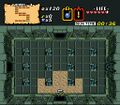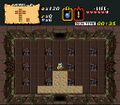BS The Legend of Zelda: Difference between revisions
m (→Major Differences: Crud...) |
(The gender thing seems like way more of an important fact.) |
||
| Line 13: | Line 13: | ||
}} | }} | ||
'''BS The Legend of Zelda''' (BSゼルダの伝説 BS Zelda no Densetsu) is a remake of the original ''[[The Legend of Zelda (Game)|Legend of Zelda]]'' game for the [[NES]] platform, except it was offered on the [[BS-X Broadcasting System]], an add-on to the popular [[SNES]] system. The gameplay was similar to the original, but there are many key differences. | '''BS The Legend of Zelda''' (BSゼルダの伝説 BS Zelda no Densetsu) is a remake of the original ''[[The Legend of Zelda (Game)|Legend of Zelda]]'' game for the [[NES]] platform, except it was offered on the [[BS-X Broadcasting System]], an add-on to the popular [[SNES]] system. The gameplay was similar to the original, but there are many key differences. | ||
''BS The Legend of Zelda'' is different from most other ''Zelda'' games as the game's central heroes are actually supposed to be the [[Mascot|mascot characters]] of the BS-X Broadcasting System, and are otherwise supposed to be based on the player as the character's name and gender is based off of the broadcasting ID, which is also true for ''[[BS Zelda no Densetsu: Inishie no Sekiban|BS The Legend of Zelda: Inishie no Sekiban]]''. The male character wears a green tunic, though others are later available, and a backwards baseball cap. The female character has long red hair and is otherwise almost exactly the same as the male. | |||
==Major Differences== | ==Major Differences== | ||
The [[Overworld]]'s size, for convenience due to the Time System, has been cut in half vertically, making it square. The [[Dungeon]]s and Overworld all look different, but the general landmarks remain the same. The game also included much higher quality graphics, nicer music, and the ability to choose your gender | The [[Overworld]]'s size, for convenience due to the Time System, has been cut in half vertically, making it square. The [[Dungeon]]s and Overworld all look different, but the general landmarks remain the same. The game also included much higher quality graphics, nicer music, and the ability to choose your gender. | ||
The biggest difference, however, is the time system. Due to the broadcasting nature of this game, the game had to be played in one sitting, and was only available for one hour every week. This meant that, if players had "tuned in" starting in the second week, they needed to catch up very quickly. | The biggest difference, however, is the time system. Due to the broadcasting nature of this game, the game had to be played in one sitting, and was only available for one hour every week. This meant that, if players had "tuned in" starting in the second week, they needed to catch up very quickly. | ||
Revision as of 03:29, 3 January 2012
BS The Legend of Zelda (BSゼルダの伝説 BS Zelda no Densetsu) is a remake of the original Legend of Zelda game for the NES platform, except it was offered on the BS-X Broadcasting System, an add-on to the popular SNES system. The gameplay was similar to the original, but there are many key differences.
BS The Legend of Zelda is different from most other Zelda games as the game's central heroes are actually supposed to be the mascot characters of the BS-X Broadcasting System, and are otherwise supposed to be based on the player as the character's name and gender is based off of the broadcasting ID, which is also true for BS The Legend of Zelda: Inishie no Sekiban. The male character wears a green tunic, though others are later available, and a backwards baseball cap. The female character has long red hair and is otherwise almost exactly the same as the male.
Major Differences
The Overworld's size, for convenience due to the Time System, has been cut in half vertically, making it square. The Dungeons and Overworld all look different, but the general landmarks remain the same. The game also included much higher quality graphics, nicer music, and the ability to choose your gender.
The biggest difference, however, is the time system. Due to the broadcasting nature of this game, the game had to be played in one sitting, and was only available for one hour every week. This meant that, if players had "tuned in" starting in the second week, they needed to catch up very quickly.
Gameplay
At the beginning of the game, the character automatically walks into a cave, where the old man gives him or her a Wooden Sword. The dungeons are all in the same place in both the First and Second Quests, but the Overworld and dungeon interiors are completely redone between versions. The dungeons also spell out different phrases. The character must complete the eight dungeons and obtain the eight pieces of the Triforce. Two of the pieces are available in each week.
The chance to fight Ganon was only accessible for the last 15 minutes of gameplay, and it took the place of the cave where the Wooden Sword was obtained. The character used the Triforce in the second screen to open the door to Ganon's chamber. When he was defeated, the character could then talk to Zelda and leave the cave.
See also: BS Zelda no Densetsu on ![]()
Trivia
- Each of the eight dungeons in the first BS Zelda quest are in the shape of a letter. When put together, it spells out "St. GIGA".
- To continue the trend, each of the dungeons in Second Quest are in the shapes of letters, which spell out "NiNtENDO" (Nintendo).

Listings
Enemies
Glitches
Hacks
Gallery
-
The first dungeon
-
The second dungeon




